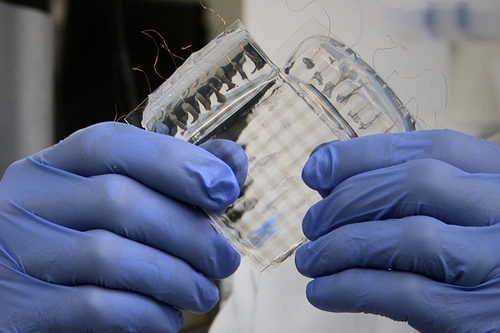By Sudarshana Banerjee
Using carbon nanotubes bent to act as springs, Stanford researchers have developed a stretchable, transparent skin-like sensor. The transparent skin-like pressure sensor is the latest developed by Stanford’s Zhenan Bao, associate professor of chemical engineering, in her quest to create an artificial “super skin.” The sensors could be used in making touch screens on computers and other devices, touch-sensitive prosthetic limbs or robots, or for various medical applications such as pressure-sensitive bandages.
The sensor can be stretched to more than twice its original length and bounce back perfectly to its original shape. It can also sense pressure from a firm pinch to thousands of pounds. The super-elasticity of the sensors ensure that none of it causes any permanent deformation.
The key element of the new sensor is the transparent film of carbon ‘nano-springs,’ which is created by spraying nanotubes in a liquid suspension onto a thin layer of silicone, which is then stretched. When the nanotubes are airbrushed onto the silicone, they tend to land in randomly oriented little clumps. When the silicone is stretched, some of the ‘nano-bundles’ get pulled into alignment in the direction of the stretching. When the silicone is released, it rebounds back to its original dimensions, but the nanotubes buckle and form little nanostructures that look like springs. “After we have done this kind of pre-stretching to the nanotubes, they behave like springs and can be stretched again and again, without any permanent change in shape,” Bao said.
Stretching the nanotube-coated silicone a second time, in the direction perpendicular to the first direction, causes some of the other nanotube bundles to align in the second direction. That makes the sensor completely stretchable in all directions, with total rebounding afterward. Additionally, after the initial stretching to produce the ‘nano-springs,’ repeated stretching below the length of the initial stretch does not change the electrical conductivity significantly, Bao said. Maintaining the same conductivity in both the stretched and unstretched forms is important because the sensors detect and measure the force being applied to them through these spring-like nanostructures, which serve as electrodes.
The sensors consist of two layers of the nanotube-coated silicone, oriented so that the coatings are face-to-face, with a layer of a more easily deformed type of silicone between them. The middle layer of silicone stores electrical charge, much like a battery. When pressure is exerted on the sensor, the middle layer of silicone compresses, which alters the amount of electrical charge it can store. That change is detected by the two films of carbon nanotubes, which act like the positive and negative terminals on a typical automobile or flashlight battery. The change sensed by the nanotube films is what enables the sensor to transmit what it is ‘feeling.’
The U.S. Intelligence Community Postdoctoral Fellowship Program and the Stanford Global Climate and Energy Program provided partial funding for the research.
(Sudarshana Banerjee is consulting editor with techtaffy.com. She can be reached at sudarshana@techtaffy.com)


